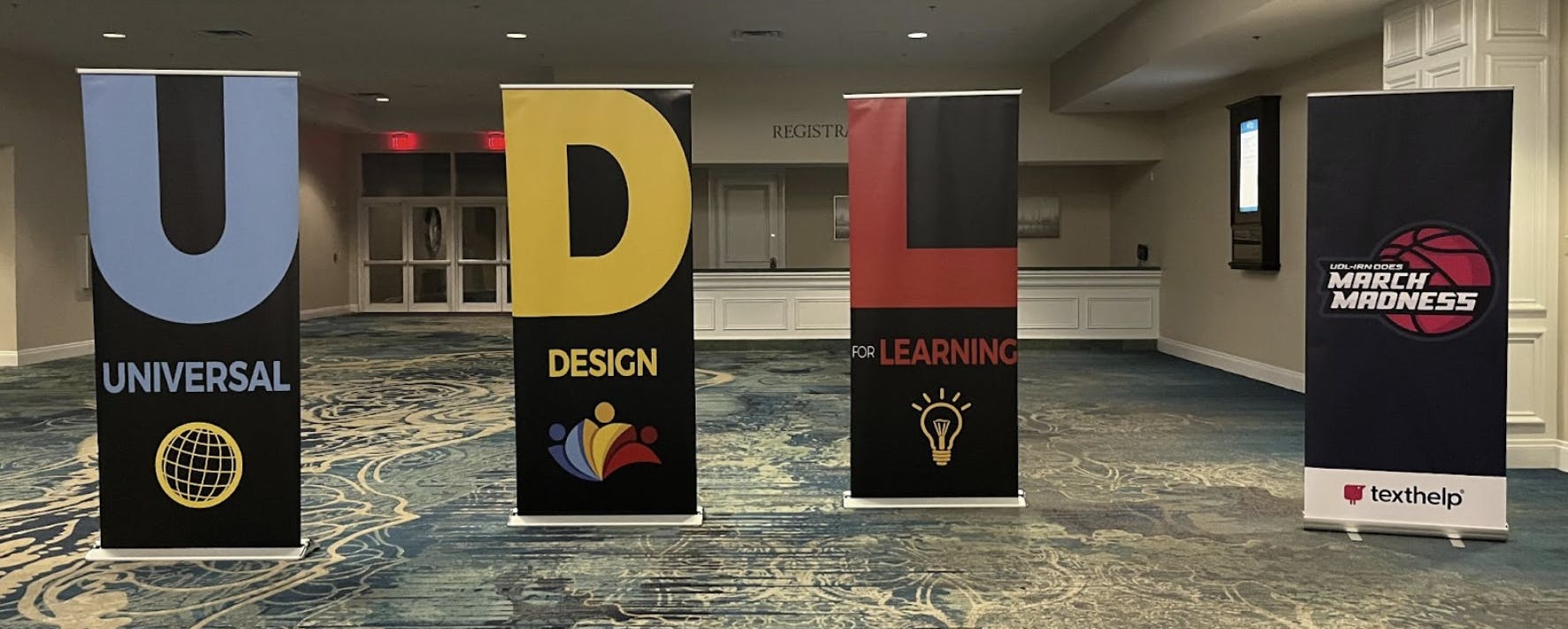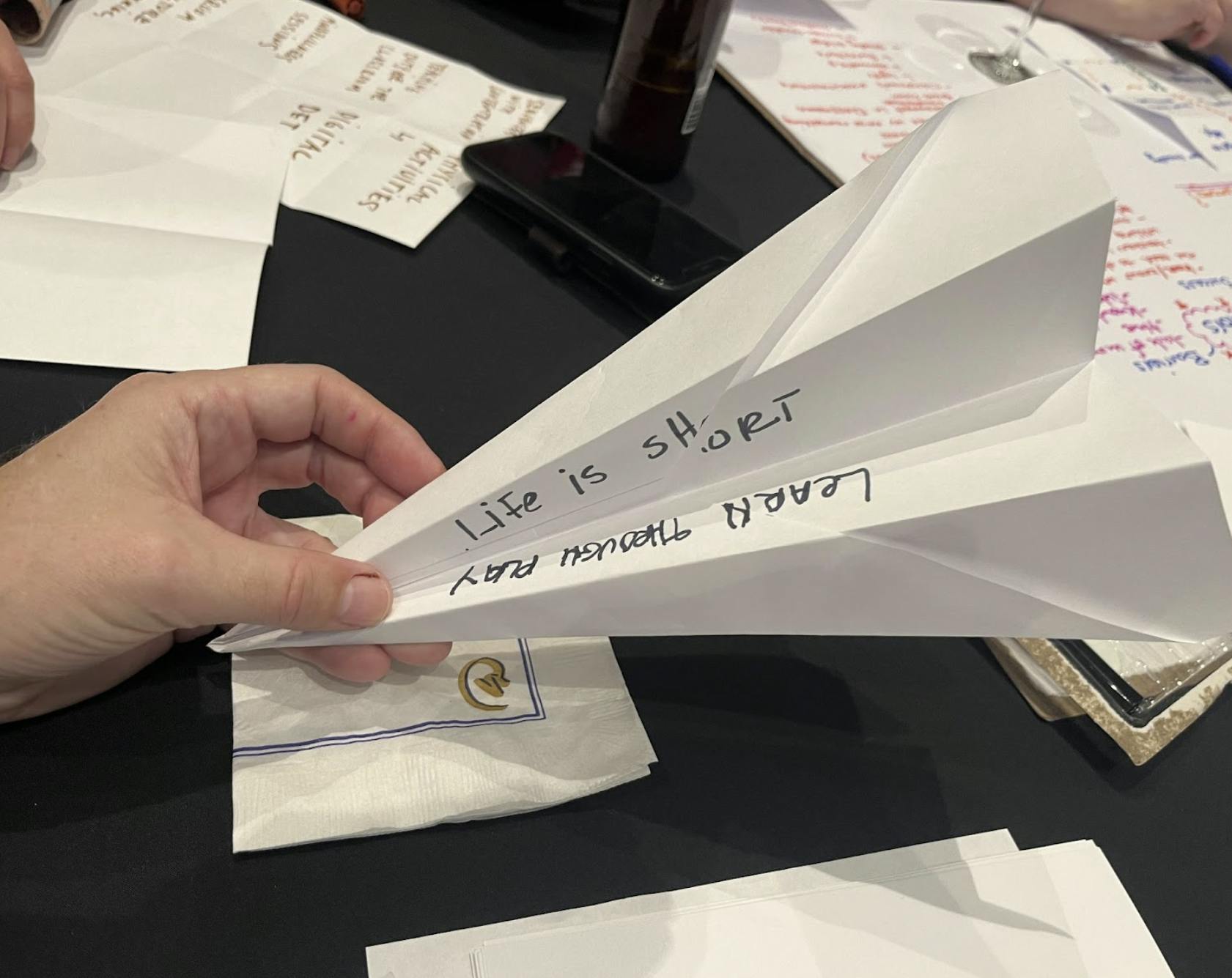UDL-IRN Summit: Can UDL help solve the biggest problems in education today?
The first session presenters on the stage at the recent UDL-IRN Summit told of when they first met. At a summit of years past, the two sat next to each other as strangers. “Do I belong here?” The question was on both Hillary Goldthwait-Fowles and Andratesha Fritzgerald’s minds.
It was answered when they found community in one another. That first conversation led to a years-long friendship between the two activists. It’s a friendship where they’ve shared a lot of hard, important conversations.
“Do I belong here?” It’s a question UDL practitioners who work in education aim to answer with a “yes,” for each and every learner they encounter.
Over two days, the UDL-IRN offered many helpful sessions to participants at many different stages in their UDL journey. Below, we highlight key summit takeaways.
Discover learnings from:
- Jason Carroll, Chief Product Officer at Texthelp
- Andratesha Fritzgerald, author of Antiracism and Universal Design for Learning
- David Reid, architect and creator of the UDL Deck of Spaces
- Rene Sanchez, Superintendent of Champlain Valley School District in Vermont
But first: What is the UDL-IRN Summit?
UDL-IRN stands for Universal Design for Learning Implementation and Research Network. It began as a grassroots organization promoting the design of research-based learning environments.
Texthelp was proud to sponsor the 2023 UDL-IRN Summit in Orlando, Florida. Attendees shared their excitement at returning to an in-person format and seeing friends and colleagues.
This year, the summit offered an on-line experience as well, expanding accessibility and choice.
“These practices not only change teaching and learning. These practices change lives.”
According to the CAST Website, Universal Design for Learning (UDL) is a framework to improve and optimize teaching and learning for all people based on scientific insights into how humans learn.
People from all over the US attend the UDL-IRN Summit to learn alongside other UDL practitioners.
Discover how Universal Design for Learning can help engage all learners in our new UDL Guide for Educators.
March Madness: The Final Four

Jason Carroll, Chief Product Officer at Texthelp, led an evening March Madness session. The goal was to brainstorm innovative solutions to some of education’s biggest challenges.
Attendees participated in a shortened version of the process illustrated in the book “Sprint, How to Solve New Problems and Test New Ideas in Five Days,” by Jake Knapp. The process was invented at Google.
It’s a method that Jason and his team use at Texthelp for creating and testing new possible products. He shortened the process to a lively two hours so session attendees could get a taste of how it works.
The challenges
Participants started the evening by helping to decide the biggest challenges in education today. According to those who voted, the biggest challenges in education are:
- Teacher Buy-In for new tech, new initiatives, etc
- Accessibility not being considered when developing lessons
- Managing a classroom of students with a wide range of different needs
- Student engagement
The methods
Tables were assigned one of the four challenges to work on as a team. Jason led the room through several exercises meant to push creative thinking and innovative solutions.
They included creating eight different versions of a single solution.
Some teams added their own creative flare, for example, the paper airplane below says, “Life is short. Learn through play.”

The solutions
Participants came up with the following solutions:
- All initiatives will follow change management/change adoption best practices to ensure teacher buy-in
- Learning Experiences will be accessible to all students through one-to-one devices, tools, training on tools for all students, teachers, and families.
- Focus on creating a healthy Tier 1 by providing students options for engaging with and access of instruction. A variety of resources and scaffolds must be available to ensure equity and success for ALL students.
- Start with Problem-Based Learning (PBL) and use a Learner Active Technology-Infused Classroom (LATIC)
Other UDL-IRN learnings were:
- UDL plays nicely with other initiatives.
Many of the districts and schools represented at the conference have combined UDL with MTSS, equity goals, or blended learning initiatives.
- It’s powerful to call people in.
Antratesha Fritzgerald pointed to professor Loretta J. Ross’ approach to activism in several of her sessions. Ross encourages “calling people in” instead of calling them out, meaning to invite people to learn instead of publicly pointing out a wrong doing. This approach was evident in Fritzgerald’s sessions. She offered her audience warmth and vulnerability when speaking about uncomfortable subjects like race and equity. The audience responded with a standing ovation.
- Many school districts work with UDL consultants
To help them shape and implement UDL practices in their district. Kavita Rao, Novak Education, and Loui Lord Nelson were some of the UDL consultants mentioned in sessions. Working with a consultant can help a district organize and individualize a plan, implement best practices, and create a UDL culture to build on.
- Solving one barrier can unexpectedly offer a solution to another.
When UDL-IRN presenter Rene Sanchez was assistant superintendent of operations in South Bend, Indiana, he introduced Wi-Fi to several school buses. He wanted students to be able to do homework on long bus rides to and from school or athletic events. This was just before the pandemic in 2020. When schools shut down and virtual school began, the district sent out the buses to bring internet access to students. Because they already had several buses with wi-fi in place, they were able to add Wi-Fi to more buses and serve more students, quickly.
- Instructional practices are a great place to start engaging students and supporting executive function.
When it comes to some of the behavioral and executive function problems students are experiencing, instructional practices may be a perfect place to start. “You can be delivering content all day, but if learning is not happening, it’s not teaching,” said Andratesha.
- UDL-IRN summit participants are excited for the forthcoming updated UDL Guidelines.
The forthcoming new guidelines are informed by the UDL Rising to Equity Initiative. But Andratesha pointed out that designing for your learners should be the primary way you shape your UDL practice. Learner variability is so rich, it can be impossible to anticipate it all. Being proactive but flexible and responsive is important.
- A thoughtfully designed UDL environment can be a teacher itself.
Architect David Reid, who created the UDL Deck of Spaces, talked about a struggling student whose learning was transformed by a UDL. David’s STEAM Studio is an in-house learning laboratory where students are invited to engage in the design thinking process. After spending time working in the studio, the struggling student took ownership of his learning and started making straight A’s.
- Successful UDL requires supportive relationships and community. Those can be found by collaborating with colleagues, creating a UDL team, and finding online community.
Or perhaps, as was the case with Hillary Goldthwait-Fowles and Andratesha Fritzgerald, it’s as simple as turning to a stranger at a conference.
